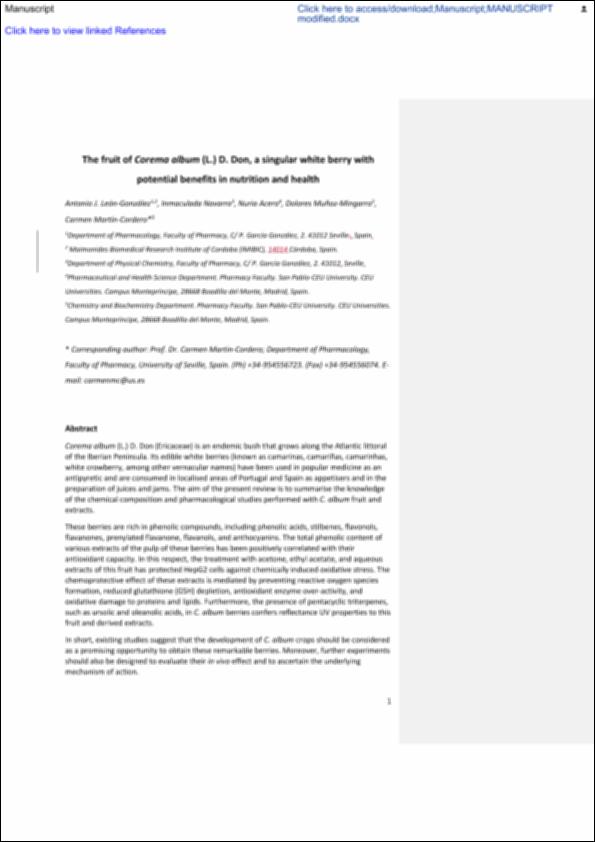Por favor, use este identificador para citar o enlazar este ítem:
http://hdl.handle.net/10637/15707The fruit of Corema album (L.) D. Don, a singular white berry with potential benefits in nutrition and health
| Título : | The fruit of Corema album (L.) D. Don, a singular white berry with potential benefits in nutrition and health |
| Autor : | León-González, Antonio J. Navarro, Inmaculada Acero de Mesa, Nuria Muñoz Mingarro, Dolores Martín-Cordero, Carmen |
| Materias: | Corema album; Ericaceae; Berries; Antioxidant; Chemoprotection |
| Editorial : | Springer |
| Citación : | A. J. León-González, I. Navarro, N. Acero, D. Muñoz-Mingarro, and C. Martín-Cordero, “The fruit of Corema album (L.) D. Don, a singular white berry with potential benefits in nutrition and health,” Phytochemistry Reviews, vol. 21, no. 2, pp. 525–536, Nov. 2021. |
| Resumen : | Corema album (L.) D. Don (Ericaceae) is an endemic bush that grows along the Atlantic littoral of the Iberian Peninsula. Its edible white berries (known as camarinas, camariñas, camarinhas, white crowberry, among other vernacular names) have been used in popular medicine as an antipyretic and are consumed in localised areas of Portugal and Spain as appetisers and in the preparation of juices and jams. The aim of the present review is to summarise the knowledge of the chemical composition and pharmacological studies performed with C. album fruit and extracts. These berries are rich in phenolic compounds, including phenolic acids, stilbenes, flavonols, flavanones, prenylated flavanone, flavanols, and anthocyanins. The total phenolic content of various extracts of the pulp of these berries has been positively correlated with their antioxidant capacity. In this respect, the treatment with acetone, ethyl acetate, and aqueous extracts of this fruit has protected HepG2 cells against chemically induced oxidative stress. The chemoprotective effect of these extracts is mediated by preventing reactive oxygen species formation, reduced glutathione (GSH) depletion, antioxidant enzyme over-activity, and oxidative damage to proteins and lipids. Furthermore, the presence of pentacyclic triterpenes, such as ursolic and oleanolic acids, in C. album berries confers reflectance UV properties to this fruit and derived extracts. In short, existing studies suggest that the development of C. album crops should be considered as a promising opportunity to obtain these remarkable berries. Moreover, further experiments should also be designed to evaluate their in vivo effect and to ascertain the underlying mechanism of action. |
| Descripción : | Esta versión está en abierto siguiendo política de la revista |
| URI : | http://hdl.handle.net/10637/15707 |
| Derechos: | http://creativecommons.org/licenses/by-nc-nd/4.0/deed.es |
| ISSN : | 1572-980X |
| Fecha de publicación : | 15-nov-2021 |
| Centro : | Universidad San Pablo-CEU |
| Aparece en las colecciones: | Facultad de Farmacia |
Los ítems de DSpace están protegidos por copyright, con todos los derechos reservados, a menos que se indique lo contrario.


